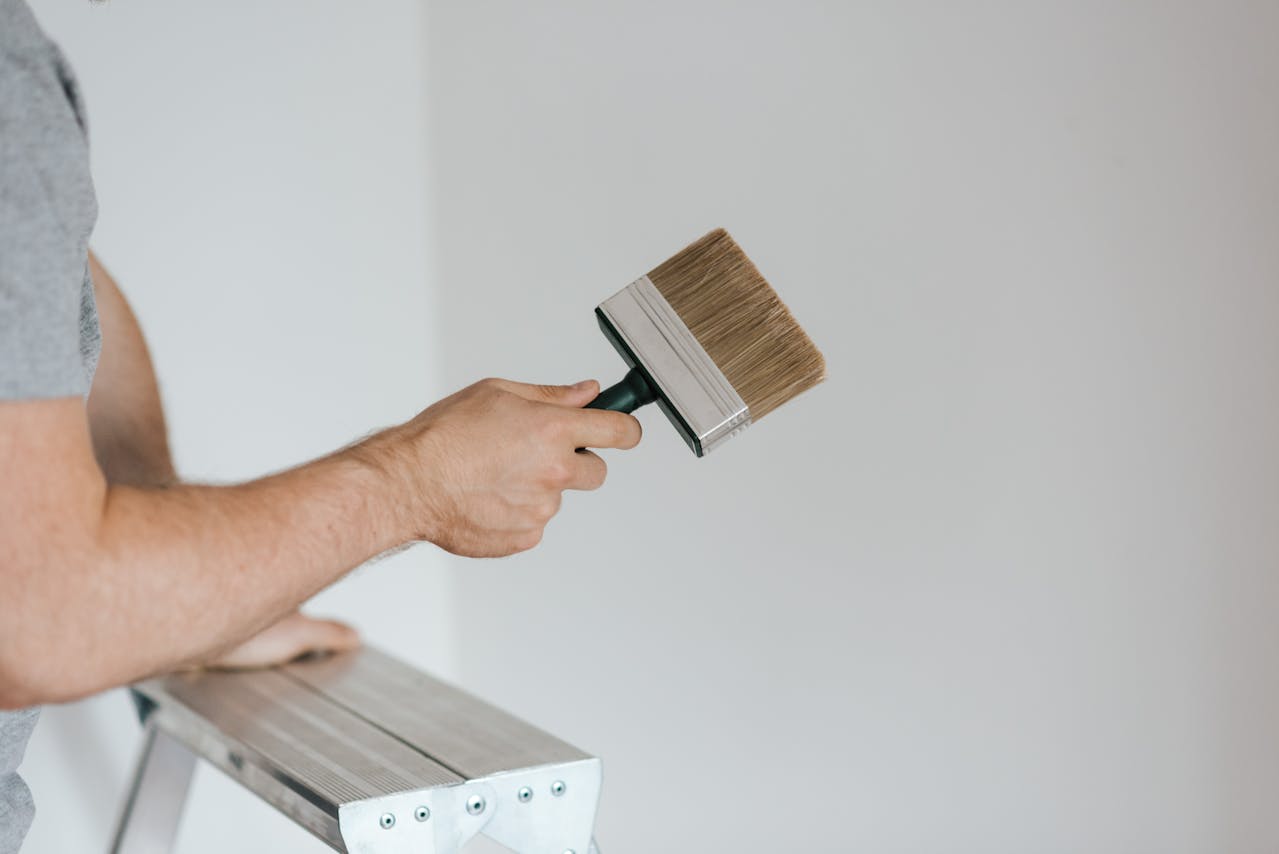
A little regular cleaning can make a big difference in how long your paint job lasts. Use a soft cloth or duster to regularly remove dust from walls and prevent dirt buildup.
When marks and stains do appear, it is important to address them quickly. This can help prevent the problem from escalating into an even bigger wall crisis.
Dust Regularly
It’s easy for dust and dirt to collect on painted walls over time, making them look dull and lifeless. Regularly dusting your walls with a microfiber cloth or a vacuum cleaner with a brush attachment will help to keep these particles from settling in the paint and creating an unattractive look. Keeping up with this cleaning routine will also prevent the buildup of natural oils, body lotions, or smoke that may stain or damage your painting job.
You’ll also want to regularly wipe down high-touch areas, such as door frames, banisters, and the area around light switches to keep these surfaces from becoming caked in grime and making your walls look dingy or damaged. This is an especially important task if you have children or pets that frequently touch the walls or furniture in your home.
Be sure to use soft, non-abrasive cleaning tools, as scouring pads or harsh brushes can scratch the surface of your paint job and damage the finish. This will quickly lead to a dull and uneven appearance. Using gentle cleaning products, such as mild soap and water solution, with a soft sponge or cloth will lower your risk of damage and allow you to maintain the sheen and texture of your paint job.
Before washing your painted walls, be sure to test the soap and water solution on an out-of-sight spot first to make sure that it doesn’t damage or remove the sheen of your paint. You’ll also want to choose a sponge or cloth that’s made of a soft, lint free material to further lower the potential for damaging your paint job while cleaning it.
For stains that aren’t too deep, you can try gently buffing them out with an absorbent white cloth. If your marks and smudges are a little more stubborn, you can try using a melamine-foam based product, such as the Magic Eraser. Again, be sure to test this product on an out-of-sight spot (behind your couch is a good choice) to avoid damaging your sheen or the color of your paint job.
Wash Your Walls Regularly
You probably vacuum your floors and sweep your rugs on a regular basis, but how often do you wash your walls? Walls can collect dust and dirt over time that can give them a dull, dirty appearance, even when the paint is still bright. Washing your walls regularly is important to maintain their appearance and extend their life.
First, be sure to dust your walls thoroughly before you begin washing them. Use a soft duster or your vacuum cleaner’s brush attachment to remove any loose debris. Don’t forget to dust corners and other hard-to-reach places, as these can be gathering points for cobwebs.
Next, you’ll want to prepare your cleaning solution. A mild cleaning detergent will typically do the trick, but be sure to test it on a small area of your painted surface to ensure that it doesn’t damage or discolor the paint. You may also want to invest in a melamine-foam-based cleaning product that is designed for use on painted surfaces.
Once you have your cleaning solution ready, start at the top of the wall and work your way down. Be sure not to over-saturate your sponge, as this can cause watermarks on the surface. Once you have completed your washing, be sure to dry your walls with a clean cloth or rag.
If you notice any stains on your painted walls, be sure to address them as quickly as possible. This will help prevent the stain from setting, which can make it much more difficult to remove. For light stains, try gently rubbing them with a damp sponge or a melamine-foam-based product (such as the Magic Eraser).
For more serious stains and dirt, you may need to use a stronger cleaning solution. However, Herts Decorators Harpenden suggests that it is always best to avoid harsh chemicals on painted walls, as these can damage or discolor the paint. If you must use a strong cleaner, be sure to apply it to a small section of your painted wall and rinse it with clean water to prevent damaging your paint job.

Address Accidental Marks and Stains Quickly
Kids’ grubby fingers, pet slobber on baseboards, stains and scratches from whatever—it’s inevitable that even the best-painted walls will eventually show signs of wear. Taking proactive steps to address these issues early—with a little effort here, a touch-up there—will help keep your walls looking pristine and beautiful for years to come.
Use Gentle Cleansers
It’s important to always clean your painted surfaces with a gentle cleaner, rather than harsh chemicals or abrasive cleaning tools. These harsher options are the archenemies of paint, quickly damaging it and leading to a dull and worn appearance. Instead, opt for gentle soap and water or cleaners that are made specifically for paint. If you’re unsure whether a cleaner is safe for your paint, test it in an inconspicuous area first.
Regularly wiping high-touch areas like door frames, banisters, and the area around light switches will also help to preserve your paint job. Staying on top of these cleaning duties will prevent buildup of natural oils, body lotions, and grime that can make your wall paint look dingy and unloved.
In addition, ensuring good ventilation in rooms like kitchens and bathrooms is also essential. Humidity can be a paint’s worst enemy, causing it to peel and bubble over time. Regularly opening windows or installing an exhaust fan in these rooms will minimize humidity levels and help safeguard your walls.
Avoid Using Hanging Hardware with Metal on Painted Walls
Those handy dangling hooks and toggle bolts that allow you to hang art, mirrors, and other decor on your walls can do serious damage to a freshly-painted surface. Whenever possible, avoid hanging items on your walls with metal fixtures and opt for stud finders and wood screws to fasten things securely.
Consider Using Washable Paint in High-Traffic Areas
If you have leftover paint from when your house was painted, it’s a great idea to keep a small amount on hand for quick and easy touch-ups when needed. Be sure to match the color and sheen of your existing paint to ensure a seamless repair. When applying the touch-up paint, be careful to lightly feather it outwards to blend in the new paint with the old layer.
Don’t Forget About Touch-Ups
Keeping your painted walls looking great is an important part of home maintenance. Regular cleaning, timely stain removal, and preventative measures go a long way to helping your painting last for years and reflect well on the care you put into your home. Whether you had your interior painting professionally completed or took on the task yourself, following these tips can help ensure that your painted surfaces look their best for as long as possible.
Dust settles on surfaces even when they aren’t touched, so it’s best to do a thorough sweep at least once per week with a microfiber cloth or your vacuum cleaner’s brush attachment. Wiping down high-touch areas like door frames, windowsills, and banisters is also a good idea to prevent buildup of natural oils, body lotions, and other grime that can damage your paint over time.
The longer you wait to address stains and spills, the harder they are to remove. Try to clean a stain as soon as you notice it, ideally before it has had the chance to dry. If you are not sure which cleaning solution is safe for your wall, start by testing a small area of the paint to make sure it does not discolor or damage the surface
Touch-ups are a must, especially in homes with kids and pets. Over time, even the most flawless surfaces can develop nicks and scrapes, and those minor imperfections can be really noticeable in comparison to their surroundings.
If you have any of the original paint from your initial painting project on hand, use that for touching up. It will give you the best results as far as color and sheen are concerned, as well as a more consistent texture with the surrounding areas of your painted wall. If you do need to buy new paint for your touch-up, make sure it is the same type as the original paint.
A good touch-up should be nearly impossible to detect, and if done correctly, it will be difficult to tell where the original spot was touched up. However, it is important to remember that no matter how well you do your touch-ups, they will never be as perfect as the original surface of your freshly painted walls.







